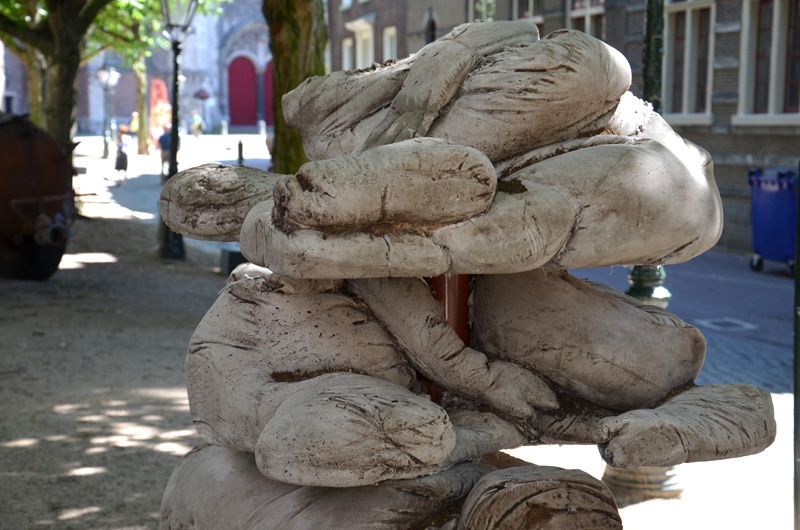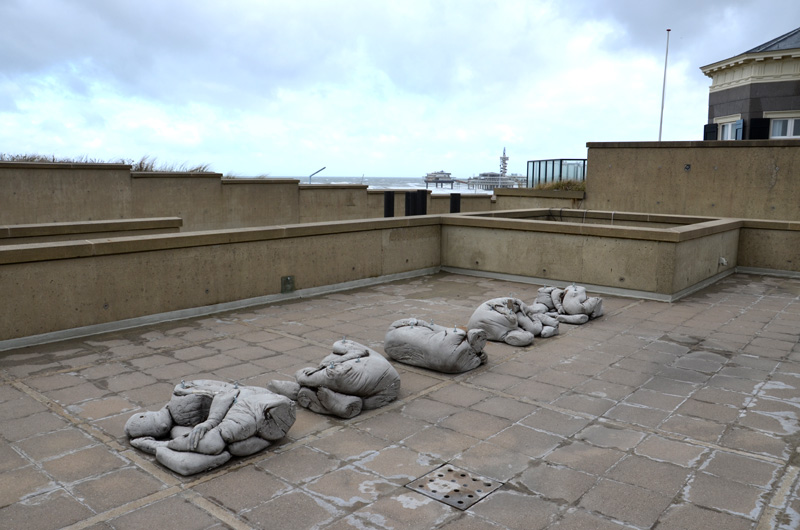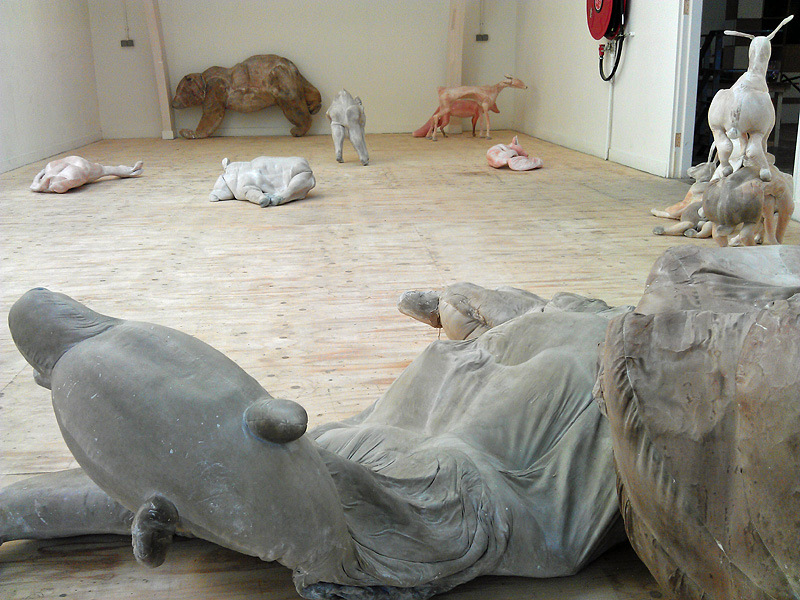Museum Beelden aan Zee placed a concrete sculpture by 26-year-old artist Catinka Kersten on the patio at the end of March: 'And everyone held their breath during that fraction of centuries'. It consists of five concrete human figures stacked on top of each other, which appear to be made of fabric. Kersten completed her studies at the Royal Academy of Art (KABK) in The Hague in 2013 with a series of hunting animals in plaster and cotton. The museum, with associated scientific institute and plaster library, is considered one of the figureheads of sculpture in the Netherlands. How did this museum come to choose such a young artist and what does inclusion in its collection mean for her?
Beelden aan Zee bought the work during the final auction of an outdoor exhibition, 'Beelden in Leiden 2014', together with a sculpture by Marleen Hartjes. Why these two?
Dick van Broekhuizen, Head of Collections and Publications at Beelden aan Zee: 'The choice was made by our director Jan Teeuwisse. He was also involved in Images in Leiden. We said to our colleague: go to the auction and bid. The advantage is also that the prices there are not so high...'
Kersten: 'I did fight for that! If you start converting, I worked for 90 euro cents an hour, but I still wanted to set a minimum price. There were some who sold their work for 300 euros! Who thought: I'm not taking that thing home anymore. But I thought: I stand behind my work, and if I have to take it back, then so be it!'
Van Broekhuizen: 'That sale is tricky. Many artists make small works, but for an exhibition like this, you can't. You have to put quite something down. And who wants to have something that big afterwards?'

No discus thrower, but hunebed
So this success story actually started in Leiden. How did curator Feico Hoekstra come to invite you?
Kersten: 'Feico unfortunately doesn't remember how he got me. That's frustrating coincidence in success, you have no control over it.'
Van Broekhuizen: 'Partly, of course, you do, because your work is attractive. We only buy work that we really want to show, and you see now what a process it is to place a large sculpture. Catinka's work ties in with our collection, in which the human figure is central, but it also has a distinct look, there is something abstract in it. Abstraction has been attracting us lately. For example, we also acquired a sculpture by Anthony Caro, which, although abstract, recalls Henry Moore's round human figures. We have an awful lot of legs, arms, breasts and heads in the museum, but we didn't have much work like this before. Catinka's sculpture consists of human figures but it is also a "weird pile".'
Kersten: "A kind of totem pole.
Van Broekhuizen: 'It is both human and abstract and that makes it interesting.'
Kersten: 'My sculpture consists of people, but it was about the form, not the individual figures. The parts were first lying next to each other on the Hooglandse Kerkgracht in Leiden and I heard from people that they found them soft, almost cuddly. Some found it unfortunate that they were stacked, because it made the sculpture less open.'
Van Broekhuizen: 'Of course it is less open. It is inert, there is little movement in it and that is special. It seems to sink into its own weight and then the challenge is that it doesn't become a dull image. Which it definitely didn't become! We have preliminary studies of Mari Andriessen's Dockworker here in the plaster library. If there is one sculpture that stands firm and stands in the earth, this is it. But even there, if you look closely, you can see all sorts of axes, construction lines, movements towards and away from the audience.'
Kersten: 'Most sculptors look for their example in the discus thrower rather than a hunebed, and this one of mine is a hunebed! Our teacher at the academy Geer Steyn used to shout through the classroom: "It's all about the direction in the rúim space!" With me, that direction is downwards. My earlier casts already wanted to go down, but when they are just lying down it is boring. Manipulation, that's what you're an artist for.'

Plaster in shellac
Van Broekhuizen: 'And then this is in monumental form. Just think how special that is! A sculpture is simply made for an exhibition! They never used to do that. Sonsbeek once wanted designs by Andriessen, so he simply put one of his plasters in shellac and they could put it outside for three months. Ruud Kuijer [whose concrete work could be seen at Beelden in Leiden, and now still at Beelden aan Zee, ed.] also does things cleverly, turning his sculptures into research projects. He has to pour concrete in one go without bubbles or holes. That is only possible with special concrete compositions. Concrete manufacturers find that interesting and they then supply the material.'
Kersten: 'Without Ruud, I could not have made this, because I use the same kind of concrete. I ended up taking four months to produce this sculpture. I got the request at the beginning of October.'
So you are taking longer to make the sculpture than it has been at the expo?
Kersten: 'Yes, that's part of it.'
Van Broekhuizen: 'And can you then estimate what will come out of it?'
Kersten: "Not at all. Half the things I make fail miserably. Then I'm not satisfied and it goes into the recycler. For my current exhibition in A Gallery Named Sue I made a lot of things that didn't make it.'
Van Broekhuizen: 'And then how do you arrive at something that is? Do you decide at some point: this has to be it?'
Kersten: 'Of course, I have only been an autonomous artist for two years. It's like at the academy: if you had an assessment, there just had to be something. With an exhibition, the opening is a set moment. So far that has gone well, but there is a risk that one time I won't have it ready.'
Material plus something in your head
Do you take longer on the idea or the making?
Kersten: 'Both take a very long time with me. I also have to recharge and think in between. Recently, I was just messing around with work and I have a job. As a result, I didn't experience enough, didn't get inspired. I have become a boring person!'
Van Broekhuizen: 'You become your own moving company as an artist at some point.'
Kersten: 'Too little was happening in my head. I need non-useful nonsense. Next week I will finish an exhibition, and then I have no exhibitions until the beginning of October. I will take courses - I want to try working with glass -, read, see exhibitions. To many people, that sounds like recreation, but it's not. I am not going to make any concrete works, but I will be in my studio a lot and just messing around. My plaster animals were also created when I was through and started messing around with material. Material plus something that occupies your mind, from that comes everything. I get very annoying during such a period. At parties, you can't have a normal conversation with me, I get completely bogged down in one thing.
Van Broekhuizen: 'In art, development always starts with thinking that you want something. And when you want something everyone says: that's impossible! And then you go and see whether you can do it. That's the process, and that's why you have to have the opportunity to mess around.'
Kersten: "And then you have to have the clarity to pick out the good idea.

How important is the move from galleries to a museum for you?
Kersten: 'Very important! When I graduated from KABK, I had a list of three places where I would like to have a work in the collection within 15 years. First, the Kröller-Müller museum, because I learned to love contemporary art there as a child. Second, the Caldic collection, because I find it so beautiful, so full of humour and wonder. And thirdly, museum Beelden aan Zee. It is one of the few institutions that focuses entirely on sculpture. For that reason alone, I love it .
Besides, it is a beautiful building. I cannot believe that I have already achieved two goals of my 15-year plan within a year of graduation: a work in Beelden aan Zee and one in the Caldic collection. For a young artist, this means invaluable recognition. Furthermore, people in a museum are fortunately not interested in how nice a sculpture looks next to their sofa. Some buyers see your work as design without function, which did shock me. The sculpture here in the museum is actually a somewhat uncomfortable thing, and that is allowed. Here I can say what I want to say with it, in a living room it is more difficult.'
Drowning man
Can you comment on the title, 'And everyone held their breath during that fraction of centuries'?
Kersten: 'That one comes from a story by Gabriel García Márquez, "The most beautiful drowning man in the world". I read that while working on the sculpture. It takes place on a deserted, stony coast near Lima, where a drowning man washes ashore. The women of the village go to prepare him for burial. During the deposition, they become impressed by his person. They find him terribly beautiful, although he is not really beautiful, rather impressive.
They start attributing all kinds of traits to him, which leads to self-reflection. They want him to be part of them, a family member, and they start thinking: we are not good enough for him. From that comes the desire to get better, and that's what I care about. At the end, they throw him from the cliff back into the sea, because the ground there is too hard to bury people, but without a stone at their feet, as they do with other dead people. The question is: after such an experience, does the sense of wanting to better yourself stay? Do you wake up or stay asleep? That is also the origin of religion I think. People do realise they have responsibility, but they ignore it and pass it off. Before on a God, now on... indifference, I sometimes think.'
Van Broekhuizen: 'The story is actually also about sculpting. The way they tinker with that corpse...'
Kersten: "Yes. They are "herding" him.
Van Broekhuizen: "And it's about entering into a relationship with an inanimate thing.
Kersten: 'One of the things that happens is when they give him a name. After a while, they think he really is an Esteban. One woman disagrees at first, but later she has to admit: it ís just an Esteban! Seeing an inanimate thing as alive also happens with art. Art should be able to exist and continue to exist independently of you as a spectator'.
Van Broekhuizen: 'In Leiden, the university is studying people's relationship with images. People kissing with images, for example. They enter into a certain relationship with an object, not just sexual. There are people who see an image as something alive, something magical.'
Kersten: 'That's also why I can do more with a sculpture than a painting. A painting stays more at a distance.'
Fine dust and burns
Van Broekhuizen: 'Sculpture is very crude and earthy, you work enormously with materials, much more than I realised while studying art history.'
Kersten: 'Yes, I can see those art historians then studying an object with white gloves, while I work with lungs full of fine dust, hands scraped open, burns...'
Van Broekhuizen: 'You hear it, Catinka is also a romantic who dying just gives her last interview.'
Now yes, Niki de St Phalle really did die working with plastics, for example.
Kersten: 'I sanded a floor the other day. I had bought the best kind of dust mask, but the dust is everywhere in your room. I didn't sleep for three days because I couldn't breathe. But anyway, that's part of the job.'
Van Broekhuizen: 'Even Leonardo da Vinci thought sculpting was the least pleasant art form, because he said: when you sculpt you always look like a baker.'
Kersten: 'And then they didn't even know back then the real effects on your lungs of that marble dust!'
More information:
Photo above: Catinka Kersten and Dick van Broekhuizen watch the installation (author's photo)
